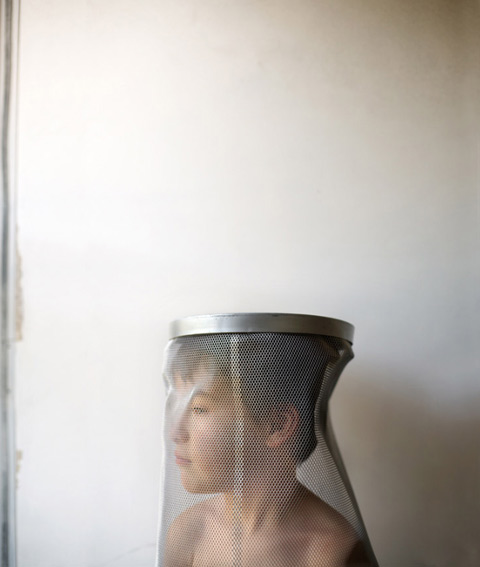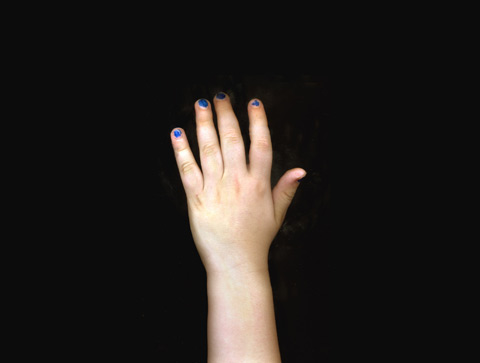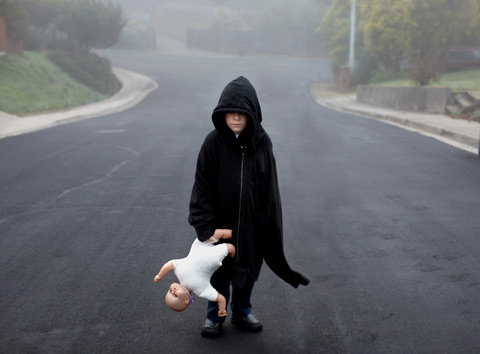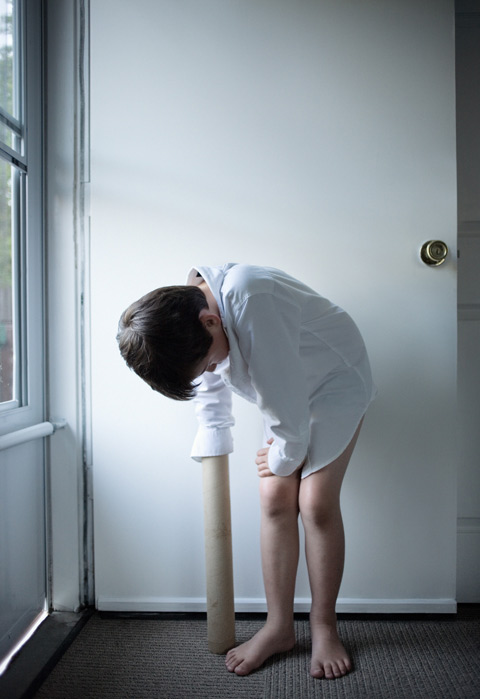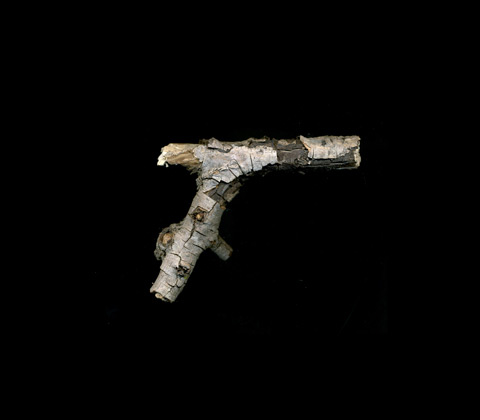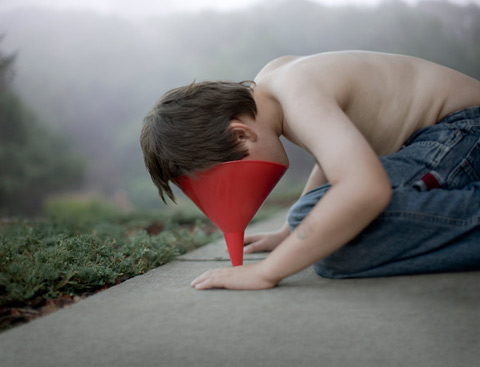1\ audience ----- international students (not just Chinese international students)
or how can communicate culture shock of Chinese international students to other international students
2\ work in process---- participate
not wait in the final work
3\ culture shock ≠ culture + shock
= culture surprise
4\ work on 6/7 (Chinese traditional) stories like a frog in the well (to show kinds of experience in culture shock)
5\ what is the 3 stage??
2012年10月31日星期三
2012年10月28日星期日
Echolilia: Sometimes I Wonder, Timothy Archibald
Q&A: Timothy Archibald, San Francisco
by ALISON ZAVOS on SEPTEMBER 21, 2010 · 4 COMMENTS
Timothy Archibald is a San Francisco-based editorial and commercial photographer. His personal projects have appeared in the collections of Videotage in Hong Kong, The Australian Center for Photography, The Museum of Sex, NY, N.Y., and The Catskill Center for Photography in Woodstock N.Y. This work is from his personal project, Echolilia.
You’ve been photographing your son, Elijah since he was 5 years old. Since then you have found out that he is on the autistic spectrum. How have the images changed or evolved with this discovery?
‘When I first started photographing Eli, we already knew something was up…something was different with him and the way he engaged with the world. The term “ Autistic Spectrum” and all of that never came into it. But he was different, he saw the world differently than I did, was in it in a way that was curious to me. Those differences are the things that made me want to explore him, or more accurately, to explore “the me and him relationship”, with the camera. That was the key for me: it wasn’t really just pictures of a beautiful child, but images about the relationship between he and I and the great unknown at the time. The relationship had the layers and the tension and having the great unknown…this thing I couldn’t understand, that gave us the fuel for the project. The kid…oh, he was just the innocent one’.
‘When I first started photographing Eli, we already knew something was up…something was different with him and the way he engaged with the world. The term “ Autistic Spectrum” and all of that never came into it. But he was different, he saw the world differently than I did, was in it in a way that was curious to me. Those differences are the things that made me want to explore him, or more accurately, to explore “the me and him relationship”, with the camera. That was the key for me: it wasn’t really just pictures of a beautiful child, but images about the relationship between he and I and the great unknown at the time. The relationship had the layers and the tension and having the great unknown…this thing I couldn’t understand, that gave us the fuel for the project. The kid…oh, he was just the innocent one’.
This is a very personal series, a collaboration between you and your son. What made you decide to make it public as well as release it as a book?
‘For me, the power of having experiences is the sharing of the experience. It can help others navigate their own situations, it can be cathartic to share on my end, it can open doors and shut doors too. So, you gotta share this creative stuff I always feel. My previous book (Sex Machines : Photographs And Interviews, Process 2005) was like social anthropology- really looking into other’s lives with distanced observation. I wanted to do something less literal, more beautiful, more personal, but with some emotional weight for people to carry with them. As this body of work started to form it seemed like I could do all those things with it.
‘I’ve always liked what a book can do for a story that has an arc: you can have a beginning, middle, end, work with the pairings, all those book nerd things that come into play, I love those things. But also, I thought a book, its in a home, it’s kinda private, it would probably end up on someone’s kitchen table….very domestic, like the project was. Its not larger than life on the walls of a gallery’.
How often do these photo sessions take place and how long do they usually last?
‘In the beginning his attention span was so very short, the images would be done in less than 10 minutes…and you get what you get…just very feral photography. As the project evolved and he got older and more involved, we started using film with a Hassleblad on a tripod with Polaroid tests and such, so those shoots could extend up to 45 minutes or so. But time aside, I can’t really accurately describe the intense personal focus Eli was able to have for these photo shoots. Subtle body movements and gestures under masterful control and utter focus and the operating of the Hassleblad camera and backs and dark slide insertion and every ritual nailed down and locked into place. Very intense focus on his part…and I would just kind of sit back with wonder’.
‘In the beginning his attention span was so very short, the images would be done in less than 10 minutes…and you get what you get…just very feral photography. As the project evolved and he got older and more involved, we started using film with a Hassleblad on a tripod with Polaroid tests and such, so those shoots could extend up to 45 minutes or so. But time aside, I can’t really accurately describe the intense personal focus Eli was able to have for these photo shoots. Subtle body movements and gestures under masterful control and utter focus and the operating of the Hassleblad camera and backs and dark slide insertion and every ritual nailed down and locked into place. Very intense focus on his part…and I would just kind of sit back with wonder’.
Do you decide beforehand what to photograph or does the inspiration come organically?
‘The photographs …well the good ones, all evolved organically. He would do something, act a certain way, do something with his body and I’d grab onto it. We’d then try to set aside time to do that in a place that had nice light, a simple location, someplace special and intentional. The results were always different from what we wanted to do, there was so very often a surprise we just embraced. There were of course times that I’d think I had an idea that I’d want to pursue, and it really almost always failed and looked so self conscious…so obvious that this professional photographer was trying to mess up the shot, you know? Just very transparent. Early on a friend looked at the project and said “ you know, you need to stop driving the photographs…let him lead and you’ll get what you are looking for”. He couldn’t have given me better advice’.
‘The photographs …well the good ones, all evolved organically. He would do something, act a certain way, do something with his body and I’d grab onto it. We’d then try to set aside time to do that in a place that had nice light, a simple location, someplace special and intentional. The results were always different from what we wanted to do, there was so very often a surprise we just embraced. There were of course times that I’d think I had an idea that I’d want to pursue, and it really almost always failed and looked so self conscious…so obvious that this professional photographer was trying to mess up the shot, you know? Just very transparent. Early on a friend looked at the project and said “ you know, you need to stop driving the photographs…let him lead and you’ll get what you are looking for”. He couldn’t have given me better advice’.
Do you see this as an ongoing project?
‘It’s most definitely not an ongoing project. I never wanted to be one of these Dad’s who photographed a kid over the entire arc of the kid’s life. It’s just not that interesting to me to see the passage of time. To me this “Echolilia channel” that the photographs were made during, really captures this time when I was really trying to look at the evidence in my kid and my life and figure out this mystery, try to understand this child that I just had a hard time harmonizing with. I thought we both felt like we were digging and mining this situation together to try to figure it out…or figure something out. And in the end we didn’t get any answers…..but amidst it all we built a bridge. Now we’ve met at the middle of the bridge and there is just no need to make these images any more’.
‘It’s most definitely not an ongoing project. I never wanted to be one of these Dad’s who photographed a kid over the entire arc of the kid’s life. It’s just not that interesting to me to see the passage of time. To me this “Echolilia channel” that the photographs were made during, really captures this time when I was really trying to look at the evidence in my kid and my life and figure out this mystery, try to understand this child that I just had a hard time harmonizing with. I thought we both felt like we were digging and mining this situation together to try to figure it out…or figure something out. And in the end we didn’t get any answers…..but amidst it all we built a bridge. Now we’ve met at the middle of the bridge and there is just no need to make these images any more’.
In Timothy Archibald‘s
case, photography was a way of connecting with his autistic son, Eli. Archibald
says, “I knew he was tuned differently, and I needed to build a
bridge, get inside his head, learn what made him tick.’’ He thinks autistic children always shut themselves up in their small world. To communicate
with them seems like being in the foreign country (language barrier). So the image
maybe the best way to understand them.
2012年10月27日星期六
London transport_Traffic Problem
Victor Galbraith, 1959
The better way is to stagger your working hours
Another approach to reducing peak traffic urged passengers to stagger their working hours. Galbraith's poster communicate this message simply, using an eye-catching and bold design.
Aldo Cosomati, 1927
Total number of passengers per hour.
Passing through Trafalgar Square by Bus, shown in red. Passing through the Charing Cross Underground stations, shown in blue. Here you see one reason why there is a Traffic Problem.
The pulse of London life
This poster presents the fluctuating numbers of passengers each day on London's Underground and buses. Times and causes of peak traffic are highlighted, encouraging passengers to reassess their journey.
Edward McKnight Kauffer, 1931
Shop between 10 and 4
Posters promoting shopping outside the rush hours not only reduced pressure during peak times, but also boosted off-peak travel sales for leisure activities. This powerful design is by one of London Transport's most prestigious designers.
William Kerridge Haselden, 1920
There are 20 hours of underground service--early boring trains. Trains at various slack hours during the day. And the last trains at night are spacious, unvexatious, accommodatious...But no!---Everyone perversely likes to travel at the same moment!
Traffic
As commuter numbers increased throughout the 1920s, so did overcrowding during peak travel times. This poster reminds passengers to travel at off-peak times where possible.
Actually, people just know that they caught by traffic jams, but they are not realise that the important reason which leads to traffic jam is they perversely likes to travel at the same moment!!
Feedback (from Jess)_26 Oct
1\ Communication question
How can participatory design communicate culture shock?
2\Summary
I want to explore how communicate the different stage of culture shock through participation, and also achieve empathy from Chinese international students.
3\Method
Participatory design
4\Objective:
To research what is the participatory design.
Summarize other people's theories/ examples/projects (to support your view).
---> my view: Participatory design (3 important elements)
The theory of participatory design:
You're the audience.
You're the designer.
You're the design work.
5\A view from primary researches
what the fuck is culture shock?"
-----"Don't doubt, you're in it." (A frog in the well.)
Ps: "A frog in the well" is a Chinese traditional story. A frog alway live in the well. However, he never realize that he is in it. He thinks that the shape of sky is like the mouth of the well.
How can participatory design communicate culture shock?
2\Summary
I want to explore how communicate the different stage of culture shock through participation, and also achieve empathy from Chinese international students.
3\Method
Participatory design
4\Objective:
To research what is the participatory design.
Summarize other people's theories/ examples/projects (to support your view).
---> my view: Participatory design (3 important elements)
- design work(art work)
- specific environment
- audience's interaction/ participation
The theory of participatory design:
You're the audience.
You're the designer.
You're the design work.
5\A view from primary researches
- Many people never realise that they are in "culture shock".
what the fuck is culture shock?"
-----"Don't doubt, you're in it." (A frog in the well.)
Ps: "A frog in the well" is a Chinese traditional story. A frog alway live in the well. However, he never realize that he is in it. He thinks that the shape of sky is like the mouth of the well.
Background:
Culture shock includes two
concepts like “culture surprise” and “culture shock”. (This view comes from
Fiona who is the course leader of presessional English course at University of
the Arts London.)
In surface level aspect, experiencing
different climates, foods, languages and dresses belong to culture surprise. In
deeper aspects, we suffer from different social roles, rules of behaviours and
values, which can be called “culture shock”. Culture shock most of the European
students suffer from is in surface level aspect. The extent of the change and
the effects it has on you may take you by surprise not shock. But this also
belongs to a part of culture shock.
Here a point --- ‘some people don’t realise they are in culture
shock’ from my interview. Not all culture shock are the negative
things.
With the first typographic
'culture shock' poster, I attempted to express that I don’t exactly understand
the definition of 'culture shock'. Indeed, some people think ‘culture shock’ is equal to ‘culture’ + ‘shock’. It should enable them to feel shock. As the result, I collect some words they said to show my poster. (The
small print may at first strike one as extreme.) But substantial evidence
exists to proof this phenomenon during my research. Furthermore, with my second
typographic 'culture shock' poster, I crossed off the definition of culture
shock I found on the book. It intended to appeal people to think what culture
shock is. I did more researches to answer me. I selected the first person on these posters. Because I wanted to ask audience this question as well. "Do you understand what culture shock is? Do you know something special experience of Chinese international students of culture shock? "The 'frog
in well' image doesn’t just focus on Chinese people inspire of the fact that this is a transitional story from China. This is an experiment,
which I wanted to do something less literal. The audience didn’t need to hear
this story before; you can understand that through a flip-book. All of us can realise that the frog in well on the last page of a flip-book. I selected two
images: first one and last one of flip-book to show on that 'frog in well'
poster.
订阅:
博文 (Atom)
